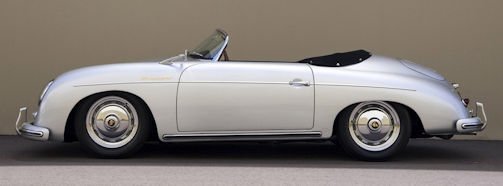Porsche 356 A
 |
|
|
Production period: |
1955-1959 |
|
Class: |
sports car |
|
Body versions: |
coupé, roadster |
|
Engines: |
1.5–1.6 litres |
|
Length: |
3950-4001mm |
|
Broad: |
1670mm |
|
Height: |
1290-1330mm |
|
wheelbase: |
2100mm |
|
curb weight: |
680-1010kg |
The second model of the 356 (from autumn 1955), which was produced throughout the entire production period in three body variants (Coupé, Cabrio, Speedster/Convertible D) with five engine types. The now one-piece, curved windscreen and door windows made of tempered glass (Security) and the dashboard padded on the top were new.
In addition, the 356 A was offered from 1958 as a hardtop cabriolet (convertible body with a fixed, removable hardtop).
The Porsche 356 A was built from October 1955 to September 1959 as a coupé, cabriolet and speedster and from 1958 as a convertible D, also from 1958 as a "hardtop" with a removable roof. The drag coefficient of the 356 A Coupé is said to have been 0.31, a very favourable value for a production sports car, compared to 0.389 for the Mercedes-Benz 300 SL. The Convertible D differs from the Speedster by having a taller windshield, a top with a larger rear window, wind-up windows, and regular upholstered seats instead of the bucket seats. The "D" stands for the body work Drauz, Heilbronn, which supplied the body. A hardtop was available as an accessory for the Cabriolet and Speedster from 1957. The 356 A was continuously developed during its production time. First of all, the then new steering dampers and greater caster of the front wheels improved the steering of the 356 A compared to the steering of its predecessor. Two spring rods, now consisting of eight spring leaves, made the front suspension softer. Another improvement was the larger wheel brake cylinders. A total of 21,045 of the 356 A.

At the beginning of the 356 A series, five engine types were in the range: 1300 with 44 hp (33 kW), 1300 S with 60 hp (44 kW), 1600 with 60 hp, 1600 S with 75 hp (55 kW) and 1500 GS "Carrera “with 100 hp (74 kW). Crankcases, cylinder heads and pistons were made of light metal in all types, and the cylinders were made of gray cast iron.
Sport versions
In 1955 the sports version of the 356 A appeared, the "1500 GS" (Gran Sport) or Porsche Carrera with 100 hp (named after the Carrera Panamericana long-distance race), which was supplemented or replaced in 1958 by two 1600 versions. With the 1959 model year, the "Carrera 1600 GT" with 115 hp (85 kW) replaced the "1500 GS Gran Turismo".
The Carrera models were lighter than the other production Porsches, among other things due to the use of light-alloy hoods and bucket seats. The "Carrera 1600 GT" can be recognized by the six additional air slots on the left and right next to the engine air grille. For sports use, a limited-slip differential, sports exhaust, central locks for the wheels (Rudge hubs), intake air funnels instead of air filters and an electrically heated windscreen could be supplied.
In 1956, 1957 and 1958 a "1500 GS Carrera" won the Gran Turismo class up to 2 litres in the 1000 km race on the Nürburgring. Paul-Ernst Straehle / Hans-Joachim Walter achieved an average of 118.61 km/h in 1958 and were therefore faster than the winner of the class over 2 litres. In 1959, the same team won the class with the "Carrera 1600 GT".
Technical
-
Specifications - 1958 model year
Porsche 356 A:
1600
1600p
Engine:
4-cylinder boxer engine (four-stroke)
Displacement:
1582cc
Bore × Stroke:
82.5×74mm
Performance:
60 hp (44 kW)
at 450075 hp (55 kW)
at 5000Max. torque at 1/min:
110 Nm at 2800
117 Nm at 3700
Compression:
7.5:1
8.5:1
valve control:
central camshaft, tappets, pushrods and rocker arms
Cooling:
air cooling (blower)
Transmission:
4-speed gearbox with Porsche ring synchronization, stick shift
Front suspension:
Crank link axle (each with two longitudinal supporting levers one above the other)
Rear suspension:
Pendulum axle with longitudinal thrust struts
Front suspension:
2 continuous square leaf spring rods on top of each other
Rear suspension:
1 round transverse torsion bar on each side
Body:
Box frame made of sheet steel, firmly connected to the floor assembly
Track width front/rear:
1306/1272mm
Wheelbase:
2100mm
Tires rim:
5.60 – 15 sports
Dimensions L × W × H:
3950 × 1670 × 1310 mm (convertible and hardtop 1290 mm)
curb weight:
Coupé 885 kg - Cabriolet 905 kg - Convertible 855 kg
Top speed:
160km/h
175km/h
Porsche 356 A:
1600 GS Carrera
"deluxe"1500 GS Carrera
"Gran Turismo"Engine:
4-cylinder boxer engine (four-stroke)
Displacement:
1587cc
1498cc
Bore × Stroke:
87.5×66mm
85×66mm
Performance:
105 hp (77 kW)
at 6500110 hp (81 kW)
at 6400Max. torque at 1/min:
121 Nm at 5000
124 Nm at 5200
Compression:
9:1
valve control:
4 overhead camshafts
(king shaft drive)Cooling:
air cooling (blower)
Transmission:
4-speed gearbox with Porsche ring synchronization, stick shift
Front suspension:
Crank link axle (each with two longitudinal supporting levers one above the other)
Rear suspension:
Pendulum axle with longitudinal thrust struts
Front suspension:
2 continuous square leaf spring rods on top of each other
Rear suspension:
1 round transverse torsion bar on each side
Body:
Box frame made of sheet steel, firmly connected to the floor assembly
Track width front/rear:
1306/1272mm
Wheelbase:
2100mm
Tires rim:
5.90 – 15 super sports
Dimensions L × W × H:
3950 × 1670 × 1310 mm (convertible and hardtop 1290 mm)
curb weight:
Coupé 885 kg - Cabriolet 905 kg - Convertible 855 kg
Top speed:
approx. 200 km/h
198km/h
model
356 A
356 1300 p
356 1500GS Carrera
356 1500 GS Carrera de Luxe
356 1500GS Carrera GT
356 1600
356 1600 p
356 1600 GS Carrera de Luxe
356 1600GS Carrera GT
Production numbers
Year
production
1955
2,952
1956
4,264
1957
5.191
1958
5,980
1959
7,032
